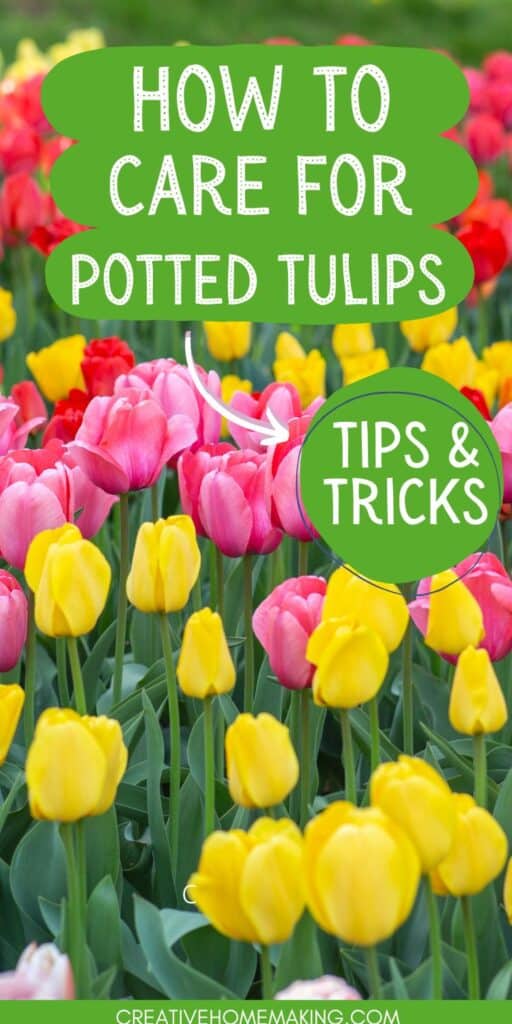Caring for potted tulips is a great way to add some color and life to your home or office. With their vibrant colors and delicate petals, tulips can brighten up any space. However, it’s important to know how to properly care for them to ensure they thrive.
This post may contain affiliate links.
Choosing the Right Pot
When it comes to potted tulips, choosing the right pot is crucial to their health and growth. Here are a few things to keep in mind when selecting a pot for your tulips:
Size Matters
The pot you choose should be large enough to accommodate the size of the bulbs you’re planting. If the pot is too small, the tulips will become overcrowded and won’t have enough room to grow properly. Conversely, if the pot is too large, the soil may not dry out properly, which can lead to root rot.
Related Article: 10 Frequently Asked Questions on Planting Tulip Bulbs
Drainage is Key
Proper drainage is essential for potted tulips. Without it, the bulbs can become waterlogged and rot. Look for a pot with drainage holes in the bottom. If the pot you want doesn’t have drainage holes, you can drill them yourself. Just make sure to add a layer of gravel or broken pottery to the bottom of the pot to help with drainage.

Related Article: When to Plant Flowers for Spring: A Helpful Guide
Material Matters
The material of the pot can also affect the health of your tulips. Clay pots are a popular choice because they are porous and allow the soil to breathe. This can help prevent overwatering and root rot. Plastic pots are also a good option, as they are lightweight and easy to move. Just make sure to choose a pot that is sturdy enough to hold the weight of the soil and tulips.
Potting Soil
Choosing the right potting soil is just as important as choosing the right pot. Look for a soil that is well-draining and nutrient-rich. Avoid using soil from your garden, as it may contain pests or diseases that can harm your tulips. Instead, opt for a high-quality potting mix that is specifically designed for container gardening.
Related Article: How to Grow Tulips
Preparing the Soil
When it comes to caring for potted tulips, soil preparation is key. Here are some steps you can take to ensure your tulips thrive in their new home.
Adding Fertilizer
Before planting your tulips, you’ll want to add some fertilizer to the soil. This will help provide the nutrients your tulips need to grow strong and healthy. There are a few different types of fertilizer you can use, including granular fertilizer, bone meal, and bulb fertilizer.
If you’re using granular fertilizer, you’ll want to mix it into the soil at a rate of about 1 tablespoon per gallon of soil. Bone meal can be added at a rate of about 1/2 cup per gallon of soil. Bulb fertilizer can be added at a rate of about 1 tablespoon per bulb.
In addition to these fertilizers, you may also want to add some compost to your soil. Compost is a great way to add organic matter to your soil, which can help improve its structure and fertility. You can mix compost into your soil at a rate of about 1/3 compost to 2/3 soil.
Finally, you may want to consider adding some perlite to your soil. Perlite is a lightweight, porous material that can help improve soil drainage. You can mix perlite into your soil at a rate of about 1/3 perlite to 2/3 soil.
By taking the time to prepare your soil properly, you can help ensure that your potted tulips have the nutrients and growing conditions they need to thrive.
Related Article: How to Grow Hyacinths
Planting Tulip Bulbs
Planting tulip bulbs is easy and can be done in a few simple steps. By following these steps, you can ensure that your potted tulips grow healthy and strong.
Pre-Chilling the Bulbs
Before planting tulip bulbs, it is important to pre-chill them. This process mimics the natural conditions that the bulbs would experience in the ground during winter, and it is necessary for the bulbs to bloom properly. To pre-chill the bulbs, follow these steps:
- Store the bulbs in a paper bag in the refrigerator for 6 to 12 weeks before planting.
- Keep the bulbs away from fruits and vegetables, as they release ethylene gas that can damage the bulbs.
- Do not freeze the bulbs, as this can kill them.
Planting Depth
When planting tulip bulbs, it is important to get the planting depth right. Planting too shallow can lead to the bulbs drying out, while planting too deep can prevent them from blooming. Here’s how to get it right:
- Choose a pot that is at least 8.5 inches (22 cm) in diameter with drainage holes.
- Fill the pot with well-draining soil, leaving about 2 inches (5 cm) of space at the top.
- Plant the tulip bulbs 4 to 8 inches deep in the soil, depending on their size. A good rule of thumb is to plant them at a depth about three times the size of the bulbs.
- Space the bulbs 2 to 5 inches apart, with the pointy end facing up.
- Cover the bulbs with soil and water thoroughly.
It is important to note that tulip bulbs need to be planted in the fall before the ground freezes. This allows them to establish roots before winter and bloom in the spring.
Related Article: Dandelion Syrup
By following these steps, you can ensure that your potted tulips grow healthy and strong. Remember to choose the right pot, use well-draining soil, and plant the bulbs at the right depth. Happy planting!
Watering and Sunlight
Watering Frequency
When it comes to watering potted tulips, it’s important to strike a balance between keeping the soil moist and avoiding excess water. Overwatering can lead to root rot and other issues, while underwatering can cause the plant to wilt and die. As a general rule, you should water your tulips when the top inch of soil feels dry to the touch.
To avoid overwatering, make sure your pot has proper drainage holes and don’t let the water level rise above the soil line. You can also add a layer of rocks or pebbles at the bottom of your pot to help with drainage. If you’re unsure whether your tulips need water, you can use a moisture meter or stick your finger into the soil to check the moisture level.
Related Article: Best Soil for Strawberries in Pots
Sunlight Requirements
Tulips thrive in full sun, but they can also tolerate partial shade. If you’re growing your tulips indoors, make sure they’re placed in a sunny window or under a grow light. If you’re growing them outdoors, choose a spot that receives at least six hours of direct sunlight per day.
It’s also important to protect your tulips from high winds, which can damage the flowers and stems. If you’re growing them outdoors, consider placing them in a sheltered area or using a windbreak to shield them from strong gusts.
Humidity
Tulips prefer a moderate to high level of humidity, so consider misting them with a spray bottle or placing a humidifier nearby if you live in a dry climate. However, be careful not to get water on the leaves or flowers, as this can lead to fungal growth and other issues.
Overall, by following these tips for watering and sunlight, you can help your potted tulips thrive and produce beautiful blooms. Remember to keep an eye on the moisture level of the soil and provide plenty of sunlight and protection from wind.
Caring for Potted Tulips
When it comes to caring for potted tulips, there are a few things you need to keep in mind to ensure that your plant thrives. In this section, we’ll cover two important aspects of caring for potted tulips: temperature and after bloom care.
Temperature
Tulips are dormant during the winter months, which means they need a period of cold temperatures to grow properly. If you’re growing potted tulips indoors, you’ll need to simulate this cold period by placing the pot in a cool, dark place for at least 12 to 16 weeks. You can use a refrigerator or a cool basement for this purpose.
Once the tulips begin to grow, you can move the pot to a warmer location with bright, indirect sunlight. Keep the temperature between 60 and 68 degrees Fahrenheit during the day and between 45 and 55 degrees Fahrenheit at night.
After Bloom Care
After your potted tulips have finished blooming, it’s important to take care of them properly to ensure they grow back healthy and strong the following year. Here are a few tips to follow:
- Cut off the dead flowers and stems, but leave the foliage intact. The leaves will continue to photosynthesize and provide nutrients to the bulbs.
- Continue to water the plant regularly, but reduce the amount of fertilizer you use.
- When the foliage begins to yellow and die back, stop watering the plant and let it dry out completely. This will allow the bulbs to go dormant and prepare for the next growing season.
- Once the foliage has completely died back, you can remove the bulbs from the pot and store them in a cool, dry place until the following fall.
By following these tips, you can ensure that your potted tulips grow back healthy and beautiful year after year.
Common Issues and Solutions
Root Rot
One common issue that can arise when caring for potted tulips is root rot. This occurs when the roots of the plant become waterlogged and begin to rot. To prevent root rot, make sure your tulip pot has adequate drainage holes to allow excess water to escape. If you notice signs of root rot, such as a foul smell or mushy roots, you may need to repot your tulip in fresh soil and trim away any damaged roots.
Soggy Soil
Another issue that can lead to root rot is soggy soil. Tulips prefer well-draining soil, so make sure your potting mix is not holding onto too much moisture. If you notice the soil is consistently wet, consider adding some sand or perlite to the mix to improve drainage. Additionally, avoid overwatering your tulips and allow the soil to dry out slightly between waterings.
Yellow Leaves
If you notice yellow leaves on your potted tulips, this could be a sign of several issues. One common cause is overwatering, which can lead to waterlogged roots and nutrient deficiencies. To fix this issue, adjust your watering schedule and make sure the soil is draining properly. Another potential cause of yellow leaves is a lack of sunlight. Tulips require at least six hours of direct sunlight each day, so consider moving your pot to a sunnier location.
Remember to monitor your tulip’s growth, leaves, bulbs, flower stalk, stem, and roots regularly to catch any potential issues early. By taking care to prevent root rot and soggy soil, and addressing yellow leaves promptly, you can help your potted tulips thrive.
Frequently Asked Questions
How long do potted tulips typically last?
Potted tulips typically last for 1 to 3 weeks after blooming. However, the lifespan of potted tulips can vary depending on factors such as temperature, light, and watering.
What type of soil is best for potted tulips?
Well-draining soil is best for potted tulips. A mix of potting soil and sand or perlite can help ensure proper drainage. It’s also important to use soil that is rich in nutrients to help the tulips grow and bloom.
Can potted tulips be replanted in soil after blooming?
Yes, potted tulips can be replanted in soil after blooming. After the tulips have finished blooming, allow the foliage to die back naturally. Once the foliage has turned yellow, remove the bulbs from the pot and plant them in the ground or in a new pot with fresh soil.
How often should potted tulips be watered?
Potted tulips should be watered when the soil feels dry to the touch. Overwatering can cause the bulbs to rot, so it’s important to avoid letting the soil become waterlogged.
What temperature is ideal for potted tulips?
Potted tulips prefer cooler temperatures, ideally between 50 and 60 degrees Fahrenheit. Avoid placing the pot in direct sunlight or near a heat source, as this can cause the soil to dry out and damage the bulbs.
Are there any special considerations for caring for potted tulips indoors?
When caring for potted tulips indoors, it’s important to ensure they receive enough light. Place the pot near a window that receives plenty of sunlight, or use artificial grow lights if necessary. Additionally, avoid placing the pot near drafts or in areas with high humidity, as this can cause the bulbs to rot.




